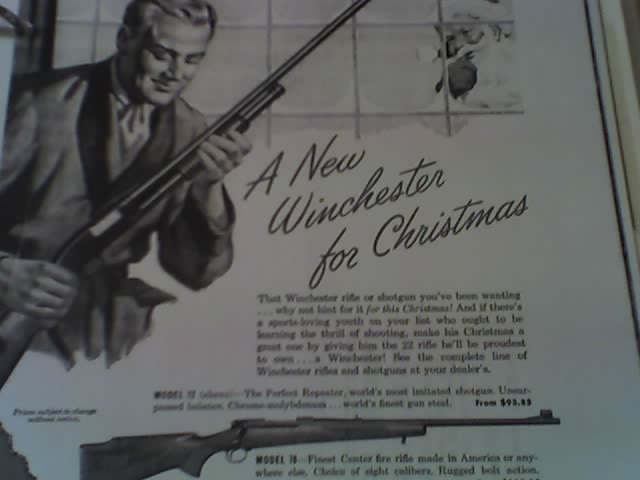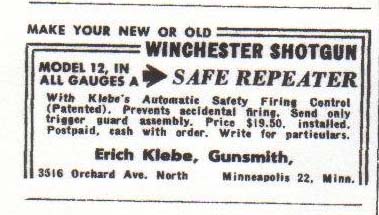1 of 1 DOCUMENT
OLIN INDUSTRIES, Inc., Plaintiff, v. Erich KLEBE, Defendant
Civ. A. No. 4818
UNITED STATES DISTRICT COURT FOR THE DISTRICT OF MINNESOTA, FOURTH DIVISION
131 F. Supp. 53; 1955 U.S. Dist. LEXIS 3153
May 5, 1955
COUNSEL: [**1]
Montreville J. Brown and John G. Robertson, of Oppenheimer, Hodgson, Brown, Baer & Wolff, St. Paul, Minn. (Pennie, Edmonds, Morton, Barrows & Taylor and Daniel V. Mahoney, New York City, of counsel), appeared in behalf of plaintiff in support of said motion.
Melvin H. Siegel, of Leonard, Street & Deinard, Minneapolis, Minn., appeared in behalf of defendant in opposition thereto.
OPINION BY:
NORDBYE
OPINION:
[*54]
Plaintiff has been engaged for many years in the manufacture and sale of small arms and small arms ammunition and is the manufacturer of the well-known Winchester rifles and shotguns. Since 1912, it has manufactured the shotgun which is commonly referred to as the Winchester Model 12 Repeating Shotgun. The gun has had wide distribution and it may be stated that it has been generally and favorably accepted by the public for use in all types of shooting for which shotguns are adapted.
Defendant is a gunsmith and under a patent issued to him on February 21, 1950, manufactures a trigger mechanism designated in the patent as an 'Automatic Safety Firing Control for Repeating Shotguns.' Apparently the mechanism is designed especially for use on a Winchester Model 12 repeating [**2] shotgun and is to prevent the gun from firing if the trigger is held back during reloading; that is, if the user fails to release the trigger of the shotgun after firing and, with the trigger depressed, manipulates the pump action to eject the empty shell and then reloads the gun, the gun will be fired automatically after the shell to be reloaded is completely chambered.
In offering his attachment to the public, defendant has used various types of advertising. In the advertisement appearing in the December, 1953, issue of a magazine entitled the 'American Rifleman', he states, 'Make Your New or Old Winchester Shotgun Model 12, in All Gauges a Safe Repeater.' The words 'Winchester Shotgun' and 'Safe Repeater' are displayed in a larger type than the remainder of the advertisement, which reads, 'With Klebe's Automatic Safety Firing Control (Patented). Prevents accidental firing.' This form of advertising, according to defendant, was published only once and then abandoned. And it is fair to assume that this type of non-explanatory advertising will not be resorted to by the defendant again. Obviously, he must inform the reader what the safety device is in some detail or the advertising [**3] would be utterly non-productive. The other advertising referred to in the complaint consists of a circular addressed by the defendant to dealers, such as sporting goods stores, etc., which requests the store owner to pass on to his customers the card enclosed with the circular. Defendant sets forth in the circular that the card explains how to make any Winchester Model 12 into a safe repeater. The following appears on the card:
'Safety First
Make Your New and Old Winchester Shotgun
Model 12 (In All Gauges) into a safe repeater
[*55] With Klebe's (Patented) Automatic Safety Firing Control which Prevents Accidental Firing
Read Other Side for Particulars'
The reverse side of the card reads:
'How to Make Your Winchester
Model 12 Shotgun Safe
Every factory made Winchester Model 12 Pump in all gauges (12, 16, and 20) will keep firing continuously like an automatic after every shot by simply holding back the trigger and repeating the gun. This imperfection causes accidents which jeopardize the life of every hunter and trapshooter. With Klebe's patented Firing Control your Winchester is positively made safe. If after any shot you accidentally hold the trigger back and [**4] repeat the gun, it will not fire until the trigger has been released and pulled again. * * *'
The above also was inserted as an advertisement in a magazine entitled the 'Sportsmen's News'.
It is conceded that the construction of plaintiff's shotgun is such that, if the trigger is held back after firing and during the reloading by the pump action, the gun will fire automatically if the shell is injected into the gun barrel. Defendant contends that experience has demonstrated that, in the handling of such a gun, especially during the excitement of hunting, a novice or even an experienced hunter may unwittingly keep his finger on the trigger during reloading and thus cause the gun to be discharged unexpectedly. On the other hand, plaintiff contends that it is instinctive to release the trigger after firing and that to assert or imply that a gun is unsafe under what may be termed abnormal or unusual handling, is definitely misleading.
No doubt to state that any gun is dangerous and a potential hazard is to utter a mere truism. Moreover, any gun will discharge unexpectedly if the user carelessly pulls the trigger with the required force. Certainly, it is well known that guns often [**5] are discharged accidentally when the user, through excitement or inexperience, unintentionally presses the trigger. However, no one would contend for that reason that the gun may be termed unsafe. Granted that the type of defendant's headline advertising implies that the Winchester gun is not a safe repeater and that therefore it wrongfully disparages plaintiff's product, the query is, Does the advertising, when considered as a whole, reflect upon the honesty of the plaintiff, or does it charge plaintiff with fraud, deceit or reprehensible conduct so that the statement is libelous per se? Plaintiff does not plead any special damages; thus, if the advertising is not libelous per se, no injunction should issue and plaintiff should be remitted to an action for damages.
At the outset, consideration should be given to the usual and probable type of readers to whom the advertising referred to would appeal. It may be stated that, generally speaking, they are a limited and informed group; that is, persons who read gun advertisements usually are interested in guns. It seems reasonably clear that neither prospective purchasers of shotguns nor owners of shotguns merely would scan the headlines [**6] and conclude therefrom that a Winchester gun is unsafe if properly used. The natural reaction to the reading of the bold type headlines would be for the reader to follow through the advertisement and to read the small print as well. Any headline in an advertisement which refers to guns and suggests that the body of the advertisement pertains to safety devices for firearms normally would urge the reader to peruse the entire advertisement. Therefore, it seems reasonable to conclude that it would be highly improbable that any prospective purchaser or user of a shotgun would draw any adverse conclusions regarding Winchester shotguns from a mere scanning of the bold type of the advertising as to which complaint herein is mainly directed. A reading of the full statement contained in the advertising will indicate that the alleged unsafety of the Winchester shotgun refers exclusively to the automatic firing on reloading [*56] if the trigger continues to be depressed, as to which there is no dispute. Whether the action of the Winchester shotgun in firing automatically upon reloading if the trigger is continuously pressed down may be considered hazardous or whether it may contribute [**7] to the causing of accidents is a matter as to which there may be differences of opinion. On this showing, at least, I cannot say that defendant's affidavits in regard to potential accidents which may occur in the use of a Winchester Model 12 shotgun under certain circumstances should be disregarded as being frivolous and without any foundation. Moreover, I cannot find on this showing that a fair construction of the entire text of the advertising promulgated by defendant 'imputes to the corporation, fraud, deceit, dishonesty, or reprehensible conduct * * *.' National Refining Co. v. Benzo Gas Motor Fuel Co., 8 Cir., 20 F.2d 763, 771, 55 A.L.R. 406. The situation presented is somewhat analogous to the use of a safety mechanism on firearms. It is well-known that the early models of shotguns, for instance, were not equipped with any safety devices; that is, there was no device to be manipulated or adjusted so that the gun could be placed on safe. Such guns were safe if handled properly, but a safety device probably would render the gun safer in the hands of the average user. To state that the attachment of such a safety device would make a gun safe or safer in the use thereof would [**8] be within the ambit of a reasonable expression of opinion.
True, the language in the advertising must be given its ordinary meaning. But the entire text must be considered, and words or phrases should not be selected and construed away from their context. The word 'safe' in general use has a relative meaning. What one person may consider safe, another person may consider unsafe. It may be safe to fire a gun in the country, but unsafe to do so in the city. One may drive an automobile at a given speed and under certain circumstances that speed is safe. However, the same speed under other circumstances may be characterized as unsafe. Some people consider it unsafe to drive an automobile without chains on a snowy or icy road. Others may be of the opinion that chains merely increase the hazard of skidding under such conditions.
It is not denied that the Winchester Model 12 is a safe gun when used as directed. But, on the other hand, an inept or excited user may not use the gun as directed and thereby at times render it unsafe. And if defendant's attachment tends to obviate accidental discharges of the gun in the hands of inexperienced users, it must be recognized that some people [**9] may opine that a safety factor is added thereby. Defendant's advertising would be more accurate and less misleading if he designated his device as a safety factor for Winchester guns, or even if he stated that, under certain circumstances, it makes Winchester guns safer. But even though one concludes that the headlines of the type of advertising used may be misleading and even ill-advised, I cannot find on this showing that the advertising considered as a whole disparages plaintiff's product so that the text is libelous per se and justifies the issuance of a temporary injunction.
In view of the premises, it is not necessary for the Court to pass upon the defendant's contention that injunctive relief cannot be issued against trade libels or disparagement in absence of an independent ground for equitable relief. See note 148 A.L.R. 853.
It follows from the foregoing that plaintiff's motion for a temporary injunction must be, and the same hereby is, denied. It is so ordered.
The temporary restraining order issued under date of March 1, 1954, and continued under date of March 4, 1954, is hereby dissolved. It is so ordered.
An exception is allowed.




























